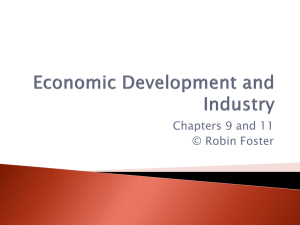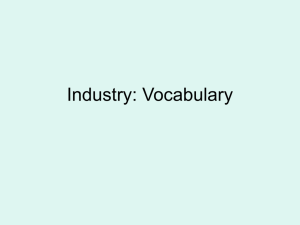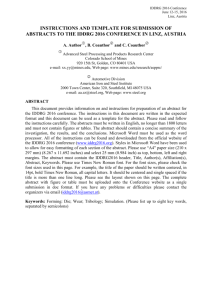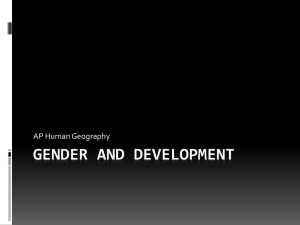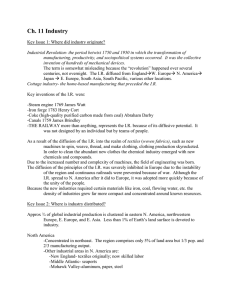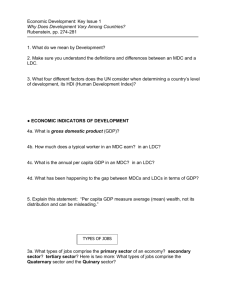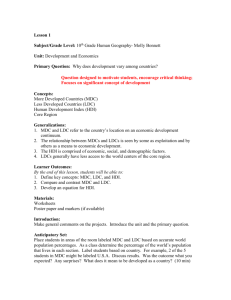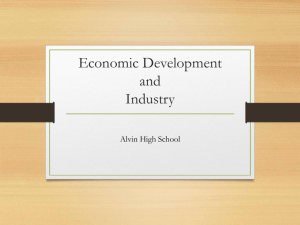Industry - Annapolis High School
advertisement
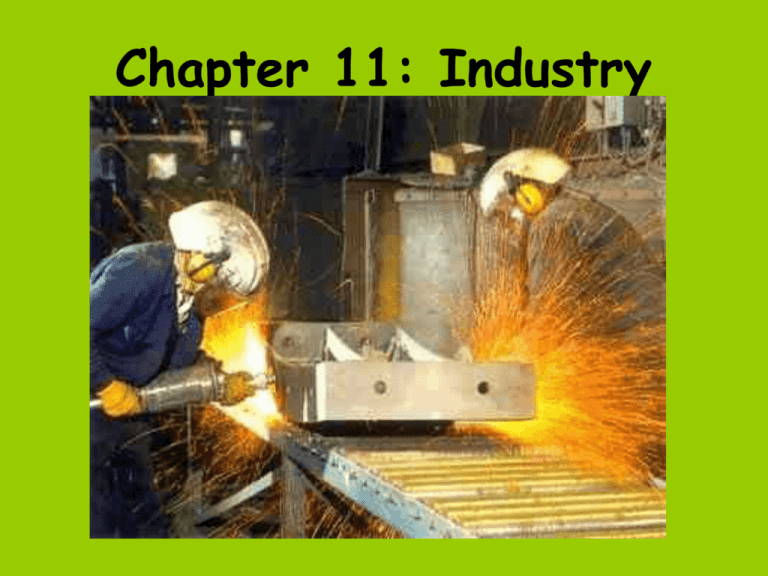
Chapter 11: Industry Two important considerations… • Where are the markets for the products located? • Where are the necessary resources located? • Increasingly industry has diffused from MDC’s to LDC’s, especially through the operation of transnational corporations. 2 Key Issue 1: Where is Industry Distributed? • Industrial revolution originated in Britain during the late 18th century due to a combination of factors: – Entrepreneurs – Capital – Raw Materials – Available Labor • Also included social and political changes of that time 3 Spatial Organization of the World Economy • Three-quarters of the world’s industrial production is concentrated in four regions: – Northwestern Europe – Eastern Europe – Eastern North American – East Asia • Western Europe has major industrial regions in Britain, the Rhine-Ruhr Valley, the mid-Rhine and Northern Italy. • The oldest industrial areas in eastern Europe are the central industrial district which is centered on Moscow, and the St. Petersburg Industrial district. – Also the Volga and Ural industrial districts 4 Why do industries have different distributions? • Situation factors involve decisions about industrial location that attempt to minimize transportation costs by considering raw material source/s as well as the market/s. – If the cost of transporting the inputs in greater than the cost of transporting the finished product, the best plant location is nearer to the inputs. – Otherwise, the best location for the factory will be closer to the consumers. 5 3/11/2016 6 The Copper Industry in North American A good example of locating near the raw material source. Copper concentration is a bulk-reducing industry. BULK REDUCING: The final product weighs less than the input Two-thirds of US copper is mined in Arizona, so most of the concentration mills and smelters are also located in Arizona. 3/11/2016 7 Other Bulk Reducing Industries? • Steel – Made by the Bessemer process • Combines iron ore and carbon at high temperatures to produce steel – Beginning in the 20th century, most of the large US steel mills were located near the East and West coasts because iron ore was coming from the other countries. 3/11/2016 8 More facts about the US steel industry… Today the US steel industry is located near major markets in minimills. It has become a FOOTLOOSE INDUSTRY One that can locate virtually anywhere because the main input is scrap metal and is available almost everywhere Today the US steel industry takes advantage of the AGGOLMERATION ECONOMIES, or sharing of services with other companies that are available at major markets. 9 Agglomeration is an extended city or town area comprising the built-up area of a central place (usually a municipality) and any suburbs linked by continuous urban area. An excellent example of an Agglomeration is the San Diego-Tijuana metropolitan area. The cities together create a bi-national agglomeration between Mexico and the United States. Another example is Silicon Valley in California. Many tech companies locate there because there is a lot talent there. 10 Deglomeration occurs when companies and services leave because of the diseconomies of industries’ excessive concentration. 11 Alfred Weber’s Theory of Industrial Location Also known as LEAST-COST THEORY Al’s theory is that the firms will locate where they can minimize transportation and labor costs as well as take advantage of agglomeration economies. 12 Weber's Location Triangle Transportation is the most important element of the model since other factors are considered to only have an adjustment effect. To solve this problem, Weber uses the location triangle within which the optimal is always located. The above figure illustrates the issue of minimizing transport costs. Considering a product of w(M) tons to be offered at market M, w(S1) and w(S2) tons of materials coming respectively from S1 and S2 are necessary. The problem resides in finding an optimal factory location P located at the respective distances of d(M), d(S1) and d(S2). 13 Bulk-Gaining Industries Determined largely by the markets because they gain volume or weight during production Most drink bottling industries are examples of bulk-gaining industries Empty cans or bottles are brought to the bottler, filled and shipped to consumers 14 Break-of-Bulk Point Commonly, a transfer point on a transport route where the mode of transport (or type of carrier) changes and where large-volume shipments are reduced in size. For example, goods may be unloaded from a ship and transferred to trucks at an ocean port. The major modes of transportation are: Ship Rail Truck Air 15 Site Factors Location factors related to the costs of factors of production inside the plant, such as land, labor, and capital. Labor-Intensive Industries Those which the highest percentage of expenses are the cost of employees Textile and apparel production Land, which includes natural resources, is a major site factor Aluminum producers locate near dams to take advantage of hydroelectric power 16 Situation Factors • Transporting materials to and from a factory • Takes into consideration inputs: anything used to make products 3/11/2016 17 Where is Industry Expanding? Within regions in MDC’s industry has relocated to urban peripheries and rural areas from central city locations. At the interregional level, manufacturing has moved towards the south and west in the US. As industry has declined in MDC’s it has increased in LDC’s. In 1980—80% of the world’s steel was produced in MDC’s. Between 1980-2005, MDC’s share of steel production declined to 45%, and that of LDC’s increased to 55% 18 China oChina is the leading new industrial center in the world because of its low labor costs and vast consumer market. oMexico and Brazil are the leading industrial centers in Latin America, with manufacturing clustered near large cities such as Mexico City and Sao Paulo. 19 Maquiladoras Since the 1980’s, manufacturing in Mexico has moved north to take advantage of the US market. Maquiladoras, which assemble US parts and ship the finished product back to the US, have benefited from the North American Free Trade Agreement: NAFTA 20 Break down of manufacturing inside a Maquiladora 3/11/2016 21 WHAT IS NAFTA? The North American Free Trade Agreement NAFTA eliminated the majority of tariffs on products traded among the US, Canada and Mexico, and gradually phased out other tariffs over a 15-year period. Restrictions were to be removed from many categories, including motor vehicles, computers, textiles and agriculture. 22 The cost of labor is changing the spatial organization of industry around the world. •In the 20th century, textile production went from the Northeast to the Southwest to take advantage of cheaper wages •More recently, the apparel industry is located in Latin America, China and other Asian countries. •Now the US imports more than 75% of its clothing needs. •This is one part of the NEW INTERNATIONAL DIVISION OF LABOR: •Industrial jobs are transferring to LDC’s largely as a result of transnational corporations search for low-cost 23 labor. Outsourcing • Outsourcing involves the transfer of the management and/or day-to-day execution of an entire business function to an external service provider • Under the agreement the supplier acquires the means of production in the form of a transfer of people, assets and other resources from the client. The client agrees to procure the services from the supplier for the term of the contract. • Business segments typically outsourced include information technology, human resources, facilities, real estate management and accounting. • Many companies also outsource customer support and call center functions like telemarketing, market research, manufacturing and engineering. 3/11/2016 24 Some industry does remain in MDC’s • Due to skilled labor and rapid delivery to market • FORDIST APPROACH: Named for Henry Ford – Traditionally assigned each worker a specific task in a mass production industry. – POST-FORDIST production has recently become the norm in MDC’s. • It is flexible production with skilled workers characterized by teams working together, problem solving through consensus, and factory workers being treated alike regardless of their level. 25 Just in Time Delivery • When the shipment of parts and materials to a factory arrive immediately before they are needed. – This avoids the stocking of unnecessary and expensive inventory. – Cottage Manufacturing • Based in homes rather than in a factory – Commonly found before the Industrial Revolution 26 Asia’s Rise, how and when • What happened in 1858 in the west? Why was this such a notable year? • What happened in that year in India? • What about in China? • Describe the changes in India and China that happened after 1947. • What is necessary in India and China for them to make the final step to catch up with Japan and the western countries? • What does he say needs to be avoided in order for these countries to catch up? 3/11/2016 27 The END 28

